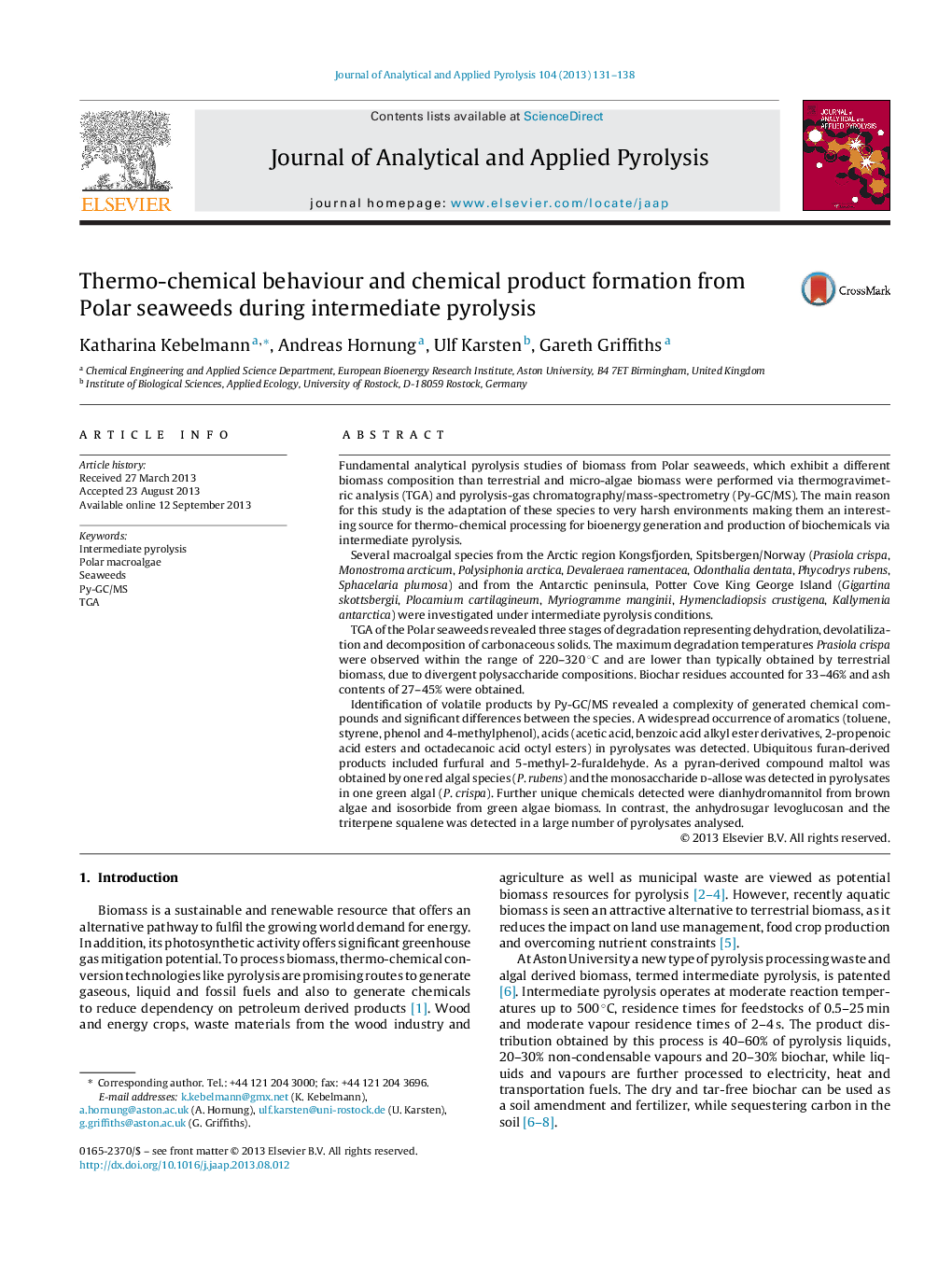| کد مقاله | کد نشریه | سال انتشار | مقاله انگلیسی | نسخه تمام متن |
|---|---|---|---|---|
| 1196771 | 1492973 | 2013 | 8 صفحه PDF | دانلود رایگان |

• Three decomposition stages of polar seaweeds observed by TGA.
• Polar seaweed biomass exhibits lower degradation temperatures as lignocellulosic biomass.
• Pyrograms of Polar seaweeds contain high levels of levoglucosan.
• Pyrograms generated are not significantly different to lignocellulosic biomass.
• Unique to Brown algae biomass was dianhydromannitol, to Green algae isosorbide.
Fundamental analytical pyrolysis studies of biomass from Polar seaweeds, which exhibit a different biomass composition than terrestrial and micro-algae biomass were performed via thermogravimetric analysis (TGA) and pyrolysis-gas chromatography/mass-spectrometry (Py-GC/MS). The main reason for this study is the adaptation of these species to very harsh environments making them an interesting source for thermo-chemical processing for bioenergy generation and production of biochemicals via intermediate pyrolysis.Several macroalgal species from the Arctic region Kongsfjorden, Spitsbergen/Norway (Prasiola crispa, Monostroma arcticum, Polysiphonia arctica, Devaleraea ramentacea, Odonthalia dentata, Phycodrys rubens, Sphacelaria plumosa) and from the Antarctic peninsula, Potter Cove King George Island (Gigartina skottsbergii, Plocamium cartilagineum, Myriogramme manginii, Hymencladiopsis crustigena, Kallymenia antarctica) were investigated under intermediate pyrolysis conditions.TGA of the Polar seaweeds revealed three stages of degradation representing dehydration, devolatilization and decomposition of carbonaceous solids. The maximum degradation temperatures Prasiola crispa were observed within the range of 220–320 °C and are lower than typically obtained by terrestrial biomass, due to divergent polysaccharide compositions. Biochar residues accounted for 33–46% and ash contents of 27–45% were obtained.Identification of volatile products by Py-GC/MS revealed a complexity of generated chemical compounds and significant differences between the species. A widespread occurrence of aromatics (toluene, styrene, phenol and 4-methylphenol), acids (acetic acid, benzoic acid alkyl ester derivatives, 2-propenoic acid esters and octadecanoic acid octyl esters) in pyrolysates was detected. Ubiquitous furan-derived products included furfural and 5-methyl-2-furaldehyde. As a pyran-derived compound maltol was obtained by one red algal species (P. rubens) and the monosaccharide d-allose was detected in pyrolysates in one green algal (P. crispa). Further unique chemicals detected were dianhydromannitol from brown algae and isosorbide from green algae biomass. In contrast, the anhydrosugar levoglucosan and the triterpene squalene was detected in a large number of pyrolysates analysed.
Journal: Journal of Analytical and Applied Pyrolysis - Volume 104, November 2013, Pages 131–138